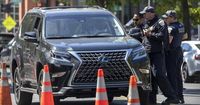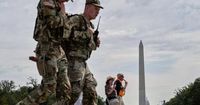On August 30, 2025, Chicago Mayor Brandon Johnson took a dramatic stand in the intensifying national debate over federal intervention in local policing. At a press conference surrounded by city officials, Johnson signed an executive order instructing Chicago police not to cooperate with federal agents or military troops if President Donald Trump follows through on his threat to send them into the city for sweeping immigration raids and crime crackdowns. The move, which Johnson described as a blueprint for “how we can stand up against this tyranny,” sets the stage for a high-profile confrontation between local and federal authorities over public safety, civil liberties, and the boundaries of presidential power.
"We do not have the luxury of time," Johnson declared, referencing credible reports that militarized federal activity could begin in Chicago within days. The executive order, effective immediately, compels city officers to remain in uniform, identify themselves, follow body camera protocols, and avoid wearing face masks—measures designed to clearly distinguish them from federal agents. The directive also urges federal personnel to follow similar procedures and refrain from masking their faces, a practice that has become increasingly common among federal agents deployed in other cities.
According to AFP via Getty Images, the mayor’s order is a direct response to President Trump’s recent actions in Washington, DC, where the National Guard and federal law enforcement were sent to restore order after the president declared a crime emergency. Trump has signaled Chicago would be “next,” raising alarm among city leaders and civil rights advocates. The president’s Border Czar, Tom Homan, has also threatened to deploy Immigration and Customs Enforcement (ICE) agents to other so-called sanctuary cities, including New York, Los Angeles, Portland, and Seattle.
Johnson’s directive isn’t just about optics. It’s an explicit attempt to draw a line between local policing—which relies on community trust and transparency—and the more opaque, sometimes intimidating tactics employed by federal agents. The order requires officers to use body cameras and avoid face coverings, both to build confidence among residents and to ensure accountability. Johnson warned that, if necessary, the city would challenge any federal military deployments in court, signaling a willingness to escalate the standoff into the legal arena.
The White House, for its part, has dismissed Johnson’s move as a political stunt. “If these Democrats focused on fixing crime in their own cities instead of doing publicity stunts to criticize the President, their communities would be much safer,” White House spokeswoman Abigail Jackson said in a statement. “Cracking down on crime should not be a partisan issue.”
This clash is not happening in a vacuum. As The Associated Press reports, the Trump administration’s strategy of deploying federal agents for law enforcement duties traditionally reserved for local police has played out in Washington and Los Angeles in recent weeks. Eyewitnesses have described scenes where masked federal agents detained individuals on city streets, bundled them into unmarked vehicles, and departed without answering questions from bystanders. These tactics have unsettled many urban leaders, police officials, and civil rights advocates, who argue that federal agents lack the training and local knowledge necessary for effective community policing.
Chuck Wexler, executive director of the Police Executive Research Forum, told AP, “They’re not navigating day-to-day contact with the public the way that police do.” Federal agencies, historically focused on major investigations and national security, are now taking on roles that put them in direct contact with city residents—often without the same protocols or oversight as local police.
One major point of contention is the use—or lack—of body cameras. Many large city police departments require officers to wear body cameras, a reform adopted after nationwide protests over police violence. These cameras are widely seen as tools for transparency, protecting both officers and the public. However, federal agencies have been slow to adopt such policies. In 2022, President Joe Biden mandated body cameras for federal officers on patrol, making arrests, or conducting searches. When Trump took office, he rescinded that order, and agencies like the Drug Enforcement Administration and U.S. Border Patrol ended their use of body-worn cameras.
Lauren Bonds, executive director of the National Police Accountability Project, emphasized the importance of these devices: “Across the board, I would say it’s an equally beneficial tool for police and for the public.” The absence of cameras on federal agents, particularly when they are operating in unfamiliar neighborhoods, has heightened concerns about accountability and the potential for abuse.
The issue of masks is another flashpoint. While most local police do not cover their faces, many federal agents do—a practice that Washington’s mayor, Muriel Bowser, has publicly questioned. “Why do they need masks?” Bowser asked. “They are federal officials. They’re paid by the taxpayers. They should be doing their jobs in a way that’s lawful and constitutional.” Federal officials, such as Deputy DHS Secretary Troy Edgar, argue that masks are needed to protect agents from harassment and doxing, citing a sharp rise in assaults against ICE agents. However, critics argue that masks make it harder for the public to identify officers and hold them accountable for their actions.
Michael Bouchard, a former assistant director at the Bureau of Alcohol, Tobacco, Firearms and Explosives, told AP, “If you’re doing the right thing, if you’re acting within the law, what do you have to hide from?” The lack of clear identification, combined with limited public information about federal arrests, has made it difficult for families to locate detained loved ones and for communities to trust the process.
Indeed, federal authorities do not provide the same level of transparency as local police. While local arrest reports are often public record, federal agencies offer only limited details, and obtaining more information typically requires a Freedom of Information Act request—a process bogged down by years-long backlogs. This opacity can leave families in the dark. Rosa Soto, for example, spent days trying to find a family friend detained by immigration authorities in California. “It feels like the systems you’re supposed to be able to trust and the due process you’re supposed to be able to trust in is no longer existent,” Soto told AP.
Community leaders worry that these federal tactics risk undoing hard-won progress in building trust between police and the neighborhoods they serve. Jaron Hickman, a senior police commander in Washington, acknowledged, “We are getting some violent people off the streets—but in the long run, at what cost?” Norm Nixon, an associate minister in Washington’s Anacostia neighborhood, echoed these concerns, saying that some young people now view local police as “traitors” aligned with federal crackdowns.
The standoff in Chicago is emblematic of a broader struggle playing out in cities across America. On one side, the Trump administration argues that federal intervention is necessary to restore order and combat crime. On the other, local officials like Johnson insist that public safety depends on trust, transparency, and the ability of communities to police themselves. The coming days will test not just the resolve of Chicago’s leaders, but the very nature of law enforcement in a democracy.
As the city braces for possible federal action, residents and officials alike are left wondering: Can local autonomy and federal authority coexist when the stakes are this high? The answer, it seems, will shape the future of American policing for years to come.

